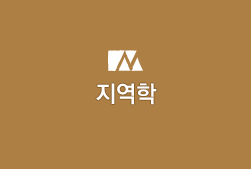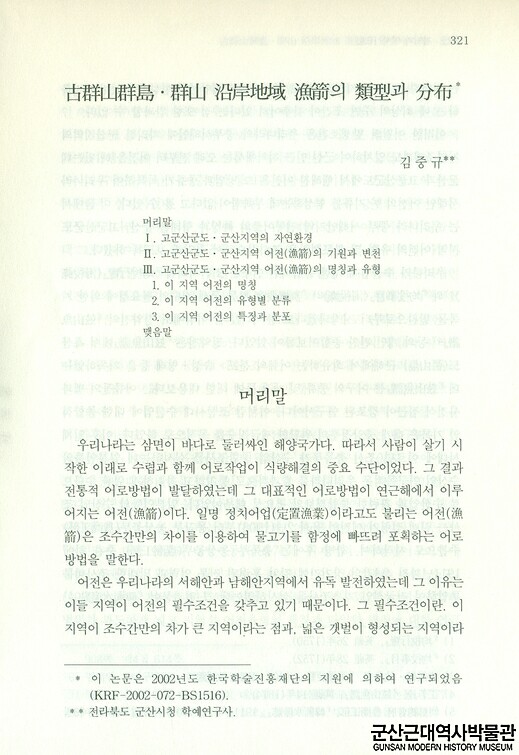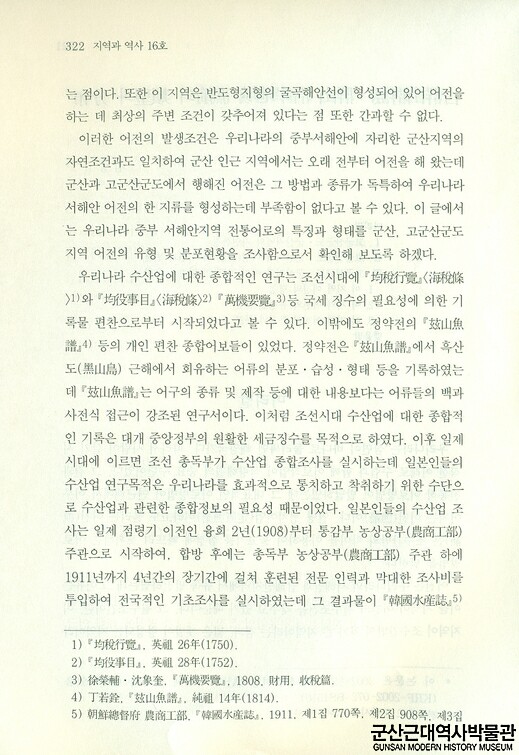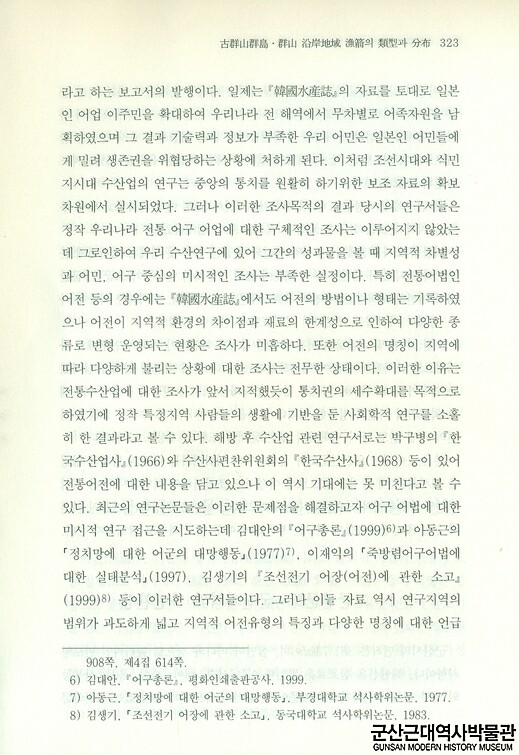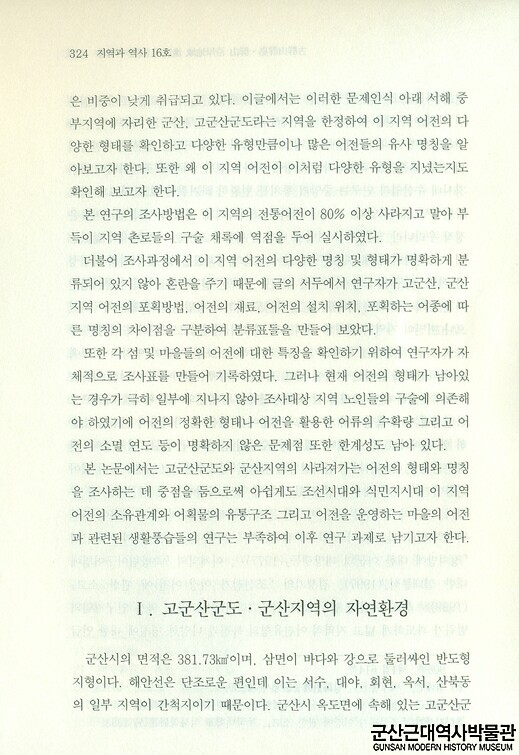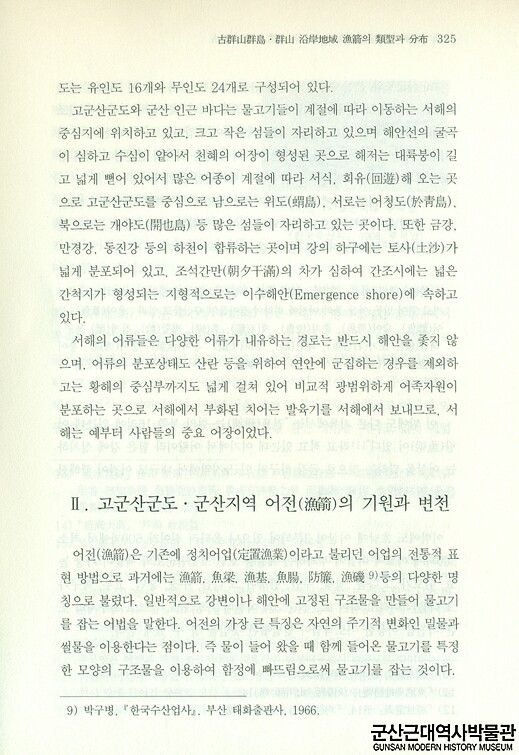
홈 > 지역학 > 근대사문헌 및 논문
근대사문헌 및 논문
지역과 역사 제16호 - 古群山群島․群山 沿岸地域 漁箭의 類型과 分布
- 카테고리 : 경영/경제 > 학위논문
- 페이지 : 28페이지
- 등록일/저작시기 : 2011.09.02 / 2005
- 자료과목 : 논문
논문미리보기
소개글
Korea features a maritime country of a peninsular surrounded by 3 sides of sea. therefore, sea feeds its eatables for human as main staple to live as well as hunting in land since human exists. As a result, traditional fishing methods have developed their variety, Hamjeong fishing method(Catching fish in a trap) as one of them have been carried out in Korean sea shore up to now. It is called Jeongchi fishing method(fixed shore net) using a difference of ebb and flow of the tide to catch fish in a trap.
Hamjeong fishing method has been carried out in Chungcheong, Jeolla in West and South coast of Korean Peninsular as well as Gyeongsang Province based on the reason that these areas meet their necessaries of fishing conditions. what are the conditions of necessaries of fishing conditions? A big difference of ebb and flow of the tide influences to create huge tide land, islands and saw-toothed coast line which will be considered the best condition for this fishing method.
This generation of Hamjeong fishing method is well match with Gunsan’s natural condition and we can trace its origin back to the earlier period of Gunsan. This dissertation only clarifies and investigates traditional Hamjeong fishing Method in the region of Gunsan and Gogunsan archipelago including islands in west coast of Korean Peninsular and the mouth of Geum River and Mankyeong River which are the target of my study for its history, circumstances, traces we can find and the its future.
The Hamjeong Fishing Method is characterized by two kind of environmental elements. The first is the artificial environmental change which has influenced to it. the other is that we can confirm the various different forms of Hamjeong Fishing Methd. In addition to this, we can grasp the situation of this traditional Hamjeong Fishing Method.
This investigation has main purpose to check the circumstances of Hamjeong Fishing Method in the region of Gunsan, Gogunsan, Geum River, Mankyeng River, and Okseo-Myeon.
As a result of this study, firstly, the traces of Hamjeong Fishing Method has been found out in Gaeya Island, Seonyu Island, Sinsi Island, Jangja Island, Bian Island, Doori Island, and Mal Island in Gogunsan Archipelago. Doksal(one kind of Hamjeong Fishing Method in trap) has been found out in Gaeya and Bian Islands and the others are Osal and Joomok mang Fishing Method.
Secondly, we can hardly find the traces of this fishing methods by the results of the reclaiming developments in near Gunsan, which has changed its environmental condition. However, we can find some trace of the Osal Fishing Method using of bamboo in Gum River and have consulted the literatures for the others. According to the literatures cited, there are the special sites for the Hamjeong Fishing Method in near Ganae Island, Naecho Island, and Haje region, and at the mouth of Mankyeong River for Osal Fishing Method.
We can analyze the environmental condition for each fishing method based on the data acquired from the results above. The first is that hard condition for the Doksal Fishing method allows to use the Osal Fishing Method with bamboo in tide land considered one unique fishing methods such as Poolmegi at Geum River, Ddolmegi which are the one kind of the Hamjeong Fishign Method developed in near Gunsan Area. The second is the ownership of these fishing gears generally belong to private or family members by the reason of paying taxes that had been levied by Government in the Joseon Dynasty. Therefore, fishing gears can be inherited or sold to others like a private asset.
We can say that this Hamjeong Fishing Method will be carried out in wide range of Gunsan Area including Gogunsan Archipelago at a large scale. In addition, We can clarify and find a solution for the lost Hamjeong Fishing Method for the better future of it and establish it right identification. Moreover, I can be sure of showing the better way for development of both cultural and tourism asset.
Hamjeong fishing method has been carried out in Chungcheong, Jeolla in West and South coast of Korean Peninsular as well as Gyeongsang Province based on the reason that these areas meet their necessaries of fishing conditions. what are the conditions of necessaries of fishing conditions? A big difference of ebb and flow of the tide influences to create huge tide land, islands and saw-toothed coast line which will be considered the best condition for this fishing method.
This generation of Hamjeong fishing method is well match with Gunsan’s natural condition and we can trace its origin back to the earlier period of Gunsan. This dissertation only clarifies and investigates traditional Hamjeong fishing Method in the region of Gunsan and Gogunsan archipelago including islands in west coast of Korean Peninsular and the mouth of Geum River and Mankyeong River which are the target of my study for its history, circumstances, traces we can find and the its future.
The Hamjeong Fishing Method is characterized by two kind of environmental elements. The first is the artificial environmental change which has influenced to it. the other is that we can confirm the various different forms of Hamjeong Fishing Methd. In addition to this, we can grasp the situation of this traditional Hamjeong Fishing Method.
This investigation has main purpose to check the circumstances of Hamjeong Fishing Method in the region of Gunsan, Gogunsan, Geum River, Mankyeng River, and Okseo-Myeon.
As a result of this study, firstly, the traces of Hamjeong Fishing Method has been found out in Gaeya Island, Seonyu Island, Sinsi Island, Jangja Island, Bian Island, Doori Island, and Mal Island in Gogunsan Archipelago. Doksal(one kind of Hamjeong Fishing Method in trap) has been found out in Gaeya and Bian Islands and the others are Osal and Joomok mang Fishing Method.
Secondly, we can hardly find the traces of this fishing methods by the results of the reclaiming developments in near Gunsan, which has changed its environmental condition. However, we can find some trace of the Osal Fishing Method using of bamboo in Gum River and have consulted the literatures for the others. According to the literatures cited, there are the special sites for the Hamjeong Fishing Method in near Ganae Island, Naecho Island, and Haje region, and at the mouth of Mankyeong River for Osal Fishing Method.
We can analyze the environmental condition for each fishing method based on the data acquired from the results above. The first is that hard condition for the Doksal Fishing method allows to use the Osal Fishing Method with bamboo in tide land considered one unique fishing methods such as Poolmegi at Geum River, Ddolmegi which are the one kind of the Hamjeong Fishign Method developed in near Gunsan Area. The second is the ownership of these fishing gears generally belong to private or family members by the reason of paying taxes that had been levied by Government in the Joseon Dynasty. Therefore, fishing gears can be inherited or sold to others like a private asset.
We can say that this Hamjeong Fishing Method will be carried out in wide range of Gunsan Area including Gogunsan Archipelago at a large scale. In addition, We can clarify and find a solution for the lost Hamjeong Fishing Method for the better future of it and establish it right identification. Moreover, I can be sure of showing the better way for development of both cultural and tourism asset.
목차
머리말
Ⅰ. 고군산군도ㆍ군산지역의 자연환경
Ⅱ. 고군산군도ㆍ군산지역 어전(漁箭)의 기원과 변천
Ⅲ. 고군산군도ㆍ군산지역 어전(漁箭)의 명칭과 유형
1.이 지역 어전의 명칭
2.이 지역 어전의 유형별 분류
3.이 지역 어전의 특징과 분포
맺음말
【Abstract】
Ⅰ. 고군산군도ㆍ군산지역의 자연환경
Ⅱ. 고군산군도ㆍ군산지역 어전(漁箭)의 기원과 변천
Ⅲ. 고군산군도ㆍ군산지역 어전(漁箭)의 명칭과 유형
1.이 지역 어전의 명칭
2.이 지역 어전의 유형별 분류
3.이 지역 어전의 특징과 분포
맺음말
【Abstract】
본문내용
Ⅰ. 고군산군도ㆍ군산지역의 자연환경
군산시의 면적은 381.73㎢이며, 삼면이 바다와 강으로 둘러싸인 반도형 지형이다. 해안선은 단조로운 편인데 이는 서수,대야,회현,옥서,산북동의 일부지역이 간척지이기 때문이다. 군산시 옥도면에 속해 있는 고군산군도는 유인도 16개와 무인도 24개로 구성되어있다.
Ⅱ. 고군산군도ㆍ군산지역 어전(漁箭)의 기원과 변천
어전은 기존에 정치어업이라고 불리던 어업의 전통적 표현방법으로 과거등으로 다양한 명칭으로 불렀다. 일반적으로 강변이나 해안에 고정된 구조물을 만들어 물고기를 잡는 어법을 말한다. 어전의 가장 큰 특징은 자연의 주기적 변화인 밀물과 썰물을 이용한다는 점이다. 즉 물이 들어 왔을 때 함께 들어온 물고기를 특정한 모양의 구조물을 이용하여 함정에 빠뜨림으로써 물괴를 잡는 것이다.
Ⅲ. 고군산군도ㆍ군산지역 어전(漁箭)의 명칭과 유형
1. 이 지역 어전의 명칭
■조선시대 어전에 대한 명칭은 다양하지만 어장. 어조. 방렴이 보편적으로 이용되었다. 여기에서 방렴이라 함은 어정의 또 다른 명칭인데 당시에는 같은 어전이라 할지라도 바다에서 이용하는 어전인'렴'과 내륙의 강에서 이용하는 어전인'살'을 구별하여 썼다. 어전이라는 명칭 안에는 전통적으로 방렴, 어장, 줄시등의 형태에 따른 각각의 유형이 있고 방렴, 어장, 줄시는 다시 어살,석방렴, 건방렴,독살 개막이. 주목망. 통발 등의 무수히 다양한 형태와 명칭을 지니고 있어 혼돈을 겪게 한다.
2.이 지역 어전의 유형별 분류
■어전의 명칭이 이처럼 다양한 유사 명칭으로 나타나는 이유는 어전의 명칭이 시대와 지역에 따라 여러 형태로 변화했기 때문인데 이 글에서는 어전의 다양한 명칭을 크게 포획 방법에 따른 도구의 차이와 포획어구를 만드는 재료의 차이점 그리고 포획 장소와 포획물의 차이에 따라 분류해보고자 한다.
3. 이 지역 어전의 특징과 분포
■이지역 어전의 유형과 분포를 확인해 보면 크게 두 가지 특징을 알 수 있는데 그 첫번째는 인위적 자연환경의 변화가 이전에 끼친 영향을 단적으로 볼 수있다는 점이다.
군산시의 면적은 381.73㎢이며, 삼면이 바다와 강으로 둘러싸인 반도형 지형이다. 해안선은 단조로운 편인데 이는 서수,대야,회현,옥서,산북동의 일부지역이 간척지이기 때문이다. 군산시 옥도면에 속해 있는 고군산군도는 유인도 16개와 무인도 24개로 구성되어있다.
Ⅱ. 고군산군도ㆍ군산지역 어전(漁箭)의 기원과 변천
어전은 기존에 정치어업이라고 불리던 어업의 전통적 표현방법으로 과거등으로 다양한 명칭으로 불렀다. 일반적으로 강변이나 해안에 고정된 구조물을 만들어 물고기를 잡는 어법을 말한다. 어전의 가장 큰 특징은 자연의 주기적 변화인 밀물과 썰물을 이용한다는 점이다. 즉 물이 들어 왔을 때 함께 들어온 물고기를 특정한 모양의 구조물을 이용하여 함정에 빠뜨림으로써 물괴를 잡는 것이다.
Ⅲ. 고군산군도ㆍ군산지역 어전(漁箭)의 명칭과 유형
1. 이 지역 어전의 명칭
■조선시대 어전에 대한 명칭은 다양하지만 어장. 어조. 방렴이 보편적으로 이용되었다. 여기에서 방렴이라 함은 어정의 또 다른 명칭인데 당시에는 같은 어전이라 할지라도 바다에서 이용하는 어전인'렴'과 내륙의 강에서 이용하는 어전인'살'을 구별하여 썼다. 어전이라는 명칭 안에는 전통적으로 방렴, 어장, 줄시등의 형태에 따른 각각의 유형이 있고 방렴, 어장, 줄시는 다시 어살,석방렴, 건방렴,독살 개막이. 주목망. 통발 등의 무수히 다양한 형태와 명칭을 지니고 있어 혼돈을 겪게 한다.
2.이 지역 어전의 유형별 분류
■어전의 명칭이 이처럼 다양한 유사 명칭으로 나타나는 이유는 어전의 명칭이 시대와 지역에 따라 여러 형태로 변화했기 때문인데 이 글에서는 어전의 다양한 명칭을 크게 포획 방법에 따른 도구의 차이와 포획어구를 만드는 재료의 차이점 그리고 포획 장소와 포획물의 차이에 따라 분류해보고자 한다.
3. 이 지역 어전의 특징과 분포
■이지역 어전의 유형과 분포를 확인해 보면 크게 두 가지 특징을 알 수 있는데 그 첫번째는 인위적 자연환경의 변화가 이전에 끼친 영향을 단적으로 볼 수있다는 점이다.
같은 분야의 연관자료
- 미리보기페이지는 5장지원됩니다.
- 문의는 박물관관리계(전화 063-450-4541, 팩스 063-443-8284)로 전화주세요





